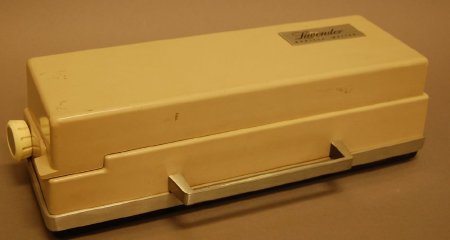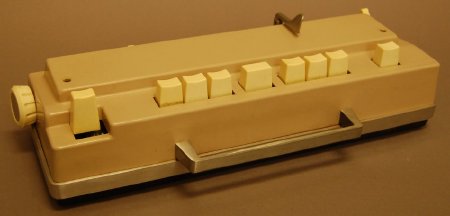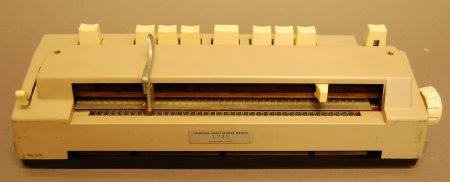Object ID:
1990.27
Title:
Lavender Braillewriter
Creator:
Lavender, Raymond, designer
Description:
The Lavender Braillewriter weighs 9 pounds, 10 ounces. The case is made of Cycolac, a high impact resistant plastic; the dust cover, which snaps on to the case, is also made of Cycolac. The Lavender writer embosses 40 cells of braille on paper 11 1/2 inches wide. The paper is not wrapped tightly around a roller, but instead is allowed to exit through an opening in the cover in a fashion somewhat similar to a conventional typewriter. A metal plate on the top is inscribed "Lavender Braille Writer." The bottom plate reads: "The Lavender Braillewriter, Serial No. L 0685, Manufactured by the American Printing House for the Blind, Louisville, Ky., U.S.A." Production of Lavender braillewriters with larger keys began in 1966. A plate on the back is inscribed "Cupertino Union School District 1248, Cupertino, Calif." "CUSD 1248" inscribed on bottom.
Date:
1962
Made by:
American Printing House for the Blind
Place of Origin:
Louisville, KY
Provenance:
Used in Cupertino Union School District 1248, Cupertino, California.
The Lavender was conceived by Raymond Lavender, a New York engineer. Between 1937 and 1941, he invented seven different machines. He designed this writer with a moving die box instead of a moving carriage, which saved space and bulk. In 1954, APH signed a contract with Lavender granting him a $500 payment and $2/writer sold during the machine's first ten years on the market. That agreement transferred all patent rights to APH. Reports until 1963 described the writer as "in the final stages of research."
The first 100 machines were shipped to schools for the blind across North America in 1963. The machine was light, 9.5 lbs including the case, and cheaper than the Perkins Braillewriter at $45.00. APH originally made 1000 machines and estimated that demand might require about a thousand machines a year. At the time, APH was selling about 500 New Hall machines, and 830 Perkins Writers annually. Actual annual production over the 17 years that APH made the Lavender averaged about 235 machines per year.
The machine had been redesigned by 1966 with larger keys. The redesign also addressed another problem-ghost dots-which plagued the initial design. Later problems which arose with the machine were due in part to warping of the plastic. The Lavender was discontinued in 1980 after a total production of 3,996 machines.
The Lavender was conceived by Raymond Lavender, a New York engineer. Between 1937 and 1941, he invented seven different machines. He designed this writer with a moving die box instead of a moving carriage, which saved space and bulk. In 1954, APH signed a contract with Lavender granting him a $500 payment and $2/writer sold during the machine's first ten years on the market. That agreement transferred all patent rights to APH. Reports until 1963 described the writer as "in the final stages of research."
The first 100 machines were shipped to schools for the blind across North America in 1963. The machine was light, 9.5 lbs including the case, and cheaper than the Perkins Braillewriter at $45.00. APH originally made 1000 machines and estimated that demand might require about a thousand machines a year. At the time, APH was selling about 500 New Hall machines, and 830 Perkins Writers annually. Actual annual production over the 17 years that APH made the Lavender averaged about 235 machines per year.
The machine had been redesigned by 1966 with larger keys. The redesign also addressed another problem-ghost dots-which plagued the initial design. Later problems which arose with the machine were due in part to warping of the plastic. The Lavender was discontinued in 1980 after a total production of 3,996 machines.


